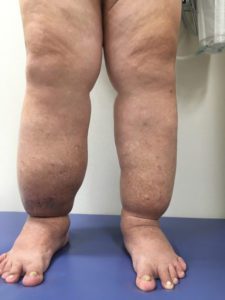 The Month of February is dedicated to cancer prevention and awareness. According to the National Cancer Institute, here in the United United States, an estimated 1,735,350 new cases of cancer will be diagnosed each year. Some of the most commonly diagnosed are breast, prostate, lung, and skin cancer.
The Month of February is dedicated to cancer prevention and awareness. According to the National Cancer Institute, here in the United United States, an estimated 1,735,350 new cases of cancer will be diagnosed each year. Some of the most commonly diagnosed are breast, prostate, lung, and skin cancer.
We focus so much on celebrating awareness, screenings, and survivorship throughout the year, but the fact is, when people are going through surgery, chemotherapy, radiation, or immunotherapy, they often feel very sick and lethargic. One of the most widespread issues with cancer treatment is lymphedema.
What is lymphedema?
Lymphedema is a build-up of lymphatic fluid throughout the body, and it is usually a secondary issue that arises after cancer treatment or lymph node removal; it can also be a critical indicator for individuals that an illness or adverse reaction is occurring in their bodies.
Lymphedema is a threatening disorder that needs to be treated and properly managed. The fluid must be safely guided through the body to remove the excess. Lymphedema can happen to anyone, but women are more susceptible to the disorder and often, are unfortunately underdiagnosed or misdiagnosed altogether. Lymphedema can cause physical debilitations and physiological distress.
Lymphedema disposes the affected area to an ongoing inflammatory process that, if untreated, can progress to skin fibrosis, adipose tissue accumulation, and further accumulation of fluid, causing disfiguring swelling, disability, and infections such as cellulitis.1
Treatment
Along with manual lymphatic massage, there are ways to control your lymphedema right in the comfort of your own home. With intermittent pneumatic pumps, individuals can use these devices, as prescribed by their specialists.
Pneumatic Pump Details
Pneumatic pumps are inflatable wraps and sleeves that are made for various parts of the body. These garments are filled with gradient pressure inflation that stimulates lymphatic fluid flow. They can be placed on the arms, back, torso, and legs. The indication for use will be tailored to each patient’s specific needs. These devices wrap around the patient’s limbs or can also cover the entire lower region. Air is used to fill the compression wrap to provide pressure in specific areas. This helps to regulate circulation and therefore is advantageous for venous insufficiency and lymphedema. The wrap is usually worn for a specified period of time each day to facilitate lymphatic drainage, increase healing and improve overall health.
Fluid and inflammation, whether lymphatic or venous, can be life-threatening. It’s critical to speak to your doctor if you are experiencing any fluid retention in your body.
Progressive Wound Solutions
239-249-1710
To find out more, contact Lester James with Progressive Wound Solutions at 239-249-1710







